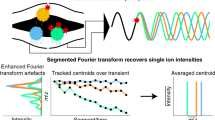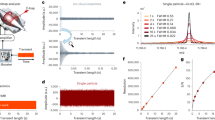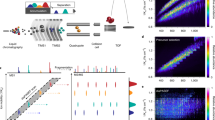Abstract
The authors have developed a semi-automated method to identify and measure metastable transitions. The data are then automatically sorted into fragmentation pathways for the molecule under examination in the mass spectrometer.
This is a preview of subscription content, access via your institution
Access options
Subscribe to this journal
Receive 51 print issues and online access
$199.00 per year
only $3.90 per issue
Buy this article
- Purchase on Springer Link
- Instant access to full article PDF
Prices may be subject to local taxes which are calculated during checkout
Similar content being viewed by others
References
Beynon, J. H., Saunders, R. A., and Williams, A. E., Table of Metastable Transitions for Use in Mass Spectrometry (Elsevier, 1965).
Barber, M., Rhodes, R. E., and Anderson, R. L., Anal. Chem., 38, 48 (1966).
Mancuso, N. R., Tsunakawa, S., and Biemann, K., Anal. Chem., 38, 1775 (1966).
Barber, M., and Elliott, R. M., Proc. Seventeenth Amer. Soc. Test. Mat., E14 Conf. Montreal (1964).
Jennings, K. R., J. Chem. Phys., 43, 4176 (1965).
Rosenstock, H. M., and Melton, C. E., J. Chem. Phys., 26, 314 (1957).
Barber, M., Jennings, K. R., and Rhodes, R., Z. Naturforsch., 15 (1967).
Author information
Authors and Affiliations
Rights and permissions
About this article
Cite this article
BARBER, M., WOLSTENHOLME, W. & JENNINGS, K. Metastable Ions in a Double Focusing Mass Spectrometer. Nature 214, 664–666 (1967). https://doi.org/10.1038/214664a0
Received:
Issue Date:
DOI: https://doi.org/10.1038/214664a0
Comments
By submitting a comment you agree to abide by our Terms and Community Guidelines. If you find something abusive or that does not comply with our terms or guidelines please flag it as inappropriate.



